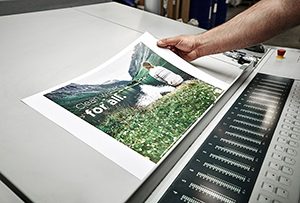Packaging MEA Editor Ben Daniel takes a closer look at the Kodak’s CTP output devices in the market and their importance to enhance workflow productivity for folding carton offset print

Since Drupa 2000, MEA regional print and packaging industry has witnessed a paradigm shift from conventional to digital workflow and imaging within the prepress space.
Drupa 2000, MEA regional print and packaging industry has witnessed a paradigm shift from conventional to digital workflow and imaging within the pre-press space.
A journey down Memory Lane
In the late 1990s, we witnessed CTP as an emerging technology whilst in the early 2000s, it became leading and top printers, as well as pre-press bureaus, preferred choice as a viable and worthy upgrade and alternative to CTF (computer-to-film).
However, post Drupa 2004 saw a major shift where CTP become more commercially viable to medium and small printers as well as CTP systems and digital plates were widely available with commercially viable rates (SQM) and the that saw the fade our of CTP/imagesetters.
Across the MEA region
I still remember when I used to closely work with prepress bureaus and offset printers where there used to be so much hype, debate and see-saw war between thermal and violet imaging devices. However, today thermal imaging has become the industry standard whilst violet is still being used by some packaging printers.
This has literally inclined and lopsided this technology race towards thermal imaging and in particular for packaging print, thermal is more or less imperative given the fact that abrasive and UV compatible inks are used widely.
Here in the region and in particular the GCC region, we see offset packaging printers in the folding cartons for the food and beverage, pharmaceutical, healthcare, confectionery and automotive markets have invested in the best digital prepress options.
Packaging MEA caught up with an industry expert and a prominent plate manufacturer and supplier for the folding carton packaging print sector to discern and feel the ground reality of this predominantly important stage within the offset print process. This is what they had to say.

Benjamin Daniel (BD): So, where is the Prepress for packaging heading, relative to digital Platesetting?
Evandro Matteucci (EM): New technologies are focused on improving efficiency and sustainability while maintaining quality. Our customers are increasingly moving to Sonora X process-free plates, which offer longer run lengths with UV than other process free plates and allow packaging printers to remove the variability of processing to increase quality and reduce the cost and inefficiencies of plate remakes. Increased automation in prepress is also vital for packaging printers, eliminating manual handling that can cause quality issues and speeding up production.
BD: What kinds of plates do you offer for diverse package printing environments?
EM: Sonora X process-free plates remove the cost, variability, and environmental impact of processing while delivering performance similar to unbaked processed plates. A technology breakthrough for process-free enables longer run lengths, better UV capability, faster imaging speeds, and more robustness than previous versions of the plate. Kodak also offers Sword Max thermal plates for even longer run lengths for packaging applications. Kodak projects the print industry could save up to 361 million liters of water, 139 million kWh of energy and 2.73 million liters of plate developer per year by using Sonora plates instead of traditional wet processed plates.
BD: What other issues about plates do you see in relation to CTP and how does your plate(s) differ from your competition?
EM: Process-free plates have many benefits, and with the new Sonora X plates, 80% of printers can now move to process free. Many of the previous barriers of process free have been eliminated with Sonora X plates, which differ from competitive process free plates with longer run lengths, superior UV capability, faster imaging speed, excellent resolution capability, and improved robustness.
BD: What plate characteristics chiefly affect package printing?
EM: Resolution is essential, to help package printers differentiate themselves with excellent print quality, accurate colours, and consistency. The durability of the plate with different substrates and the challenging inks and chemicals used for UV printing is also an important characteristic. With up to 450lpi resolution and gauge 15 to 40 VLF availability, Sonora X plates can achieve up to 400,000 impressions.
BD: With thermal process-free /processless plates getting more widely used due to environmental concerns and faster make-ready and time to market, are these plates up to the mark when it comes to on-press developing, repeatability, consistency and handles abrasive inks and long runs?
EM: Sonora X plates use new technology that delivers superior performance in all these areas. Performance is similar to unbaked plates.
BD: In terms of technology, be it Gaussian, GLV (grating light value) or Squarespot, they all are more or less the same ñ Right? What imaging technology is used in your platesetter and how is it different and better that others?
EM: Kodak Trendsetter and Magnus platesetters use Kodak Squarespot imaging technology. Squarespot technology is unique because it employs a 10,000 dpi laser swath – four times finer than a pixel. This unique ‘sub-pixel’ resolution ensures the edge of the dot on the plate is accurately and consistently imaged, resulting in a clear and consistent boundary between imaged and non-imaged areas and excellent latitude to handle the normal (or even abnormal) variations in plates, plate coatings, processing, and laser power with no noticeable variation on the printed sheet.
The design of the laser array in the Squarespot thermal imaging heads means that quality and speed continue even if several laser emitters fail – ensuring long, trouble-free operation and minimal interruption to a printer’s operation. Customers are often unaware that a failure has occurred until it is revealed during the normal service inspection by a Kodak engineer.
Dynamic autofocus, a standard feature on all of Kodak’s imaging devices using Squarespot technology, enables consistent quality to be achieved even if there are changes in the distance between the laser and the plate surface (a common problem often caused by dirt or dust), eliminating hot spots and other artefacts that may not show up until the plates are on press.
Dr. George Simonian shares his thoughts:

Technology editor, Packaging MEA and professor of Print Media
Helwan University Cairo, Egypt
As for the thermal CTP in the folding carton market in the MEA region, it’s very obvious that in the last few years thermal CTP has dominated the plate imaging space as with many advantages that the technology offers as against the others, especially for offset packaging print.
Whilst primarily CTP eliminates all the steps required by manual/conventional plate making, consuming a lot of time and human skills and that is prone to human error.
Secondly, packaging print has a lot to do with faithful and consistent colour saturation resulting in repeatability and quality print.
Therefore using thermal CTP, we can assure the first generation dot imaged on the plate is of high quality with very sharp edges and less dot gain. This reduction in dot gain will allow using more denser inks on the press; which can provide improved saturation and high print quality.
As for the digital front end – workflow and allied software, the digital files are easier to store and retrieve and make changes as and when needed.
As packaging involves long-run print jobs, the durability of the plates is of utmost importance. With baking, these plates can be used for long runs and reused if there are reprints.
Colour management is critical for packaging print. Brand colour consistency is imperative for all brands as they cannot afford variance in their brand colours.
Therefore creating LAB curves, defining these values and implementing it across prepress all the way to the press settings is a must. Thanks to the advanced digital prepress software and systems that enable this process to go through with minimum human skill and interference whilst it assures zero defect if we stick to the set parameters.
Another trend that is catching up among plate manufacturers and printers is to go process-less. The quality and time management benefits of these processes plates are going to be an industry standard pushing plate processing on the back foot.




